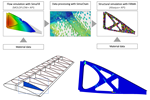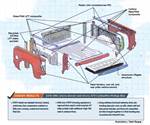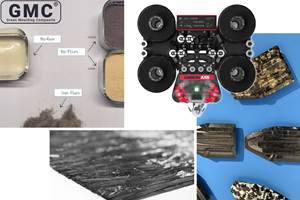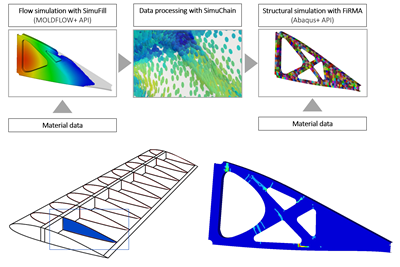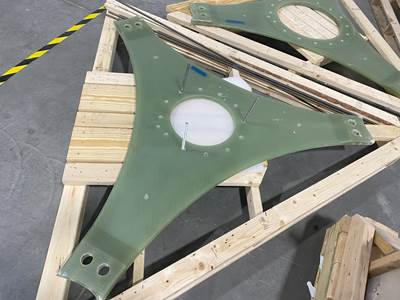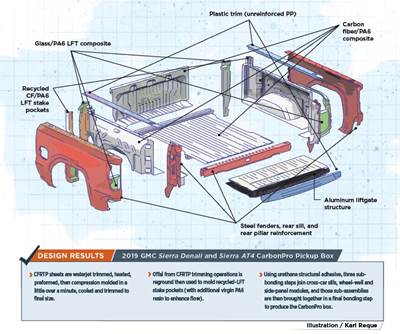Co-molding SMC with braided glass fiber demonstrates truck bed potential
Prepreg co-molding compound by IDI Composites International and A&P Technology enables new geometries and levels of strength and resiliency for automotive, mobility.
Share
Results demonstrated that a 20% thinner co-molded panel with QISO reinforcement exhibited improved puncture resistance and minimal deflection compared to a thicker SMC panel. Source | IDI Composites International
With the increased electrification of vehicles, automotive OEMs are looking to lightweight but durable materials with optimal structural properties for weight savings, extended range and fuel economy. With these core requirements in mind, what better application to showcase than a next-generation sheet molding compound (SMC) pickup truck bed?
SMC composites are not a new truck bed solution; they’ve actually been used for several years thanks to their durability, resilience and ability to withstand weathering. However, the truck bed’s role as a rugged and versatile tool was an ideal application for IDI Composites International (IDI, Noblesville, Ind., U.S.) to explore a new co-molded approach to SMC reinforcement, aimed to achieve complex geometry without additional reinforcement and durability.
IDI is a global formulator and manufacturer of thermoset molding composites and compounds for OEMs, Tier 1 suppliers and molders. It operates from a state-of-the-art, 120,000-square-foot manufacturing facility and research center. Boasting ISO-certified manufacturing processes and rigorous quality control procedures, the company collaborates closely with its customers to develop thermoset molding formulas tailored to specific applications. IDI manufactures a comprehensive range of polyester/vinyl ester-based SMC and bulk molding compounds (BMC). The company’s products — known for their durability, resilience and performance under challenging conditions — serve a variety of industries, including automotive, electric and new energy vehicles (EV, NEV), mass transportation, defense, construction, oil and gas, medical and marine.
Seeking ways to further enhance the properties of SMC/BMC, the company partnered with braided materials manufacturer A&P Technology (Cincinnati, Ohio, U.S.) to develop a prepreg co-molding compound known as Fortium QISO. The material is a combination of IDI’s Fortium SMC and QISO, a triaxial braided product developed by A&P Technology.
According to Kevin Cahill, director of composite technology and application engineering for IDI, the goal was to provide an advancement in SMC/BMC that used braided materials for additional reinforcement while also enabling the use of less material. “The main advantage is weight savings,” says Cahill. “So you would have had to have a much thicker part with the discontinuous fiber only, or you’d have to have a more complicated part with metal inserts.”
Rob Holcombe, product manager for IDI, adds, “Our clear objectives were to maintain the performance of the truck bed application, reduce weight and save on cost or at least remain cost neutral.”

The addition of A&P Technology’s QISO further enhances the performance of Fortium with quasi-isotropic properties.
Source | CW
A new class of reinforcing materials
Fortium is reinforced with 40-65% discontinuous glass fiber. This high level of reinforcement yields a material with high strength and impact resistance, while its discontinuous nature enables the materials to be molded into complex geometries via compression molding processes. Fortium can also use a variety of thermoset resins including polyester, vinyl ester, epoxy and vinyl ester/urethane hybrids to provide temperature resistance, toughness and durability including resistance to weathering, UV radiation, chemicals and regular wear and tear.
Holcombe says this choice of resins and reinforcement levels gives IDI composites the flexibility to optimize the cost and density of Fortium, making the material comparable to aluminum and steel on a performance-to-weight basis. It has already been used in the beds of many small pickup truck models.
For the development of its co-molded truck bed material, IDI used a Fortium SMC that features 50% reinforcement with 1-inch discontinuous glass fiber and a polyester/vinyl ester blend resin system. Cahill says additives provide pigmentation plus weathering and UV resistance. He notes that a similar result could be achieved with a flame-resistant material for battery enclosures.
The addition of A&P Technology’s QISO further enhances the performance of Fortium with quasi-isotropic properties. Unlike conventional woven products, QISO’s fibers are offset by 60°, providing improved strength and drapeability, crucial for the compound curvatures found in compression molded parts.
QISO is a 0°/±60° balanced and symmetric quasi-isotropic fabric. Compared to parts designed with traditional 0°/90° woven or noncrimp fabric (NCF) reinforcements, A&P says parts made with QISO are stronger, have better impact resistance and more consistent coefficient of thermal expansion (CTE). Three nonorthoganal woven biases contribute to QISO’s quasi-isotropic architecture — meaning it has the same properties in every direction, so the orientation of the fabric is not a concern. This enables simpler layups with fewer plies and a reduction in scrap.
Holcombe says that IDI selected QISO because of its flexibility and adaptability. “Getting continuous fiber sheets to form and play friendly when you’re molding — even when you’re prepregging — can be a real challenge. QISO is very friendly from a manufacturing standpoint, at a compounding level and it’s very friendly in the molding sense. Because of the format of the fibers, it’s able to conform well to complex geometries.”
“What we arrived at was something that looks, feels and acts kind of like a very thin sheet SMC,” he continues. “It doesn’t flow — because it’s a braided mat — but it’s still very familiar. It molds and it cures, the same because of the common chemistry between the two materials.”
Co-molding, testing and FEM validation
Co-molding is a manufacturing process where two or more materials are molded together to form a single part. This process allows for the combination of different materials or colors into one component. Typically, the process begins with placement of the primary material into a mold cavity. This material forms the base layer or structure of the final part. The secondary material, often with different properties, is introduced over or around the primary material and the two materials are integrated into a single part through compression molding.
A custom impact tester was used to simulate various impact scenarios and different layups and configurations of the material under impact loading. Source | IDI Composites International
With Fortium QISO, the co-molding process involves integrating QISO fabric into Fortium SMC, creating a composite with reportedly unmatched design flexibility and robustness. The QISO fabric is impregnated with the same resin system. This enables seamless co-molding, maintaining the same fiber loading by weight and density as traditional SMC. Again, the quasi-isotropic properties of QISO ensure less sensitivity to placement and orientation, reducing material scrap and enhancing manufacturing efficiency.
An additional benefit of the resulting material is in its recyclability. “It’s one type of material, so there’s no overmolded steel inserts or something that needs to be removed before recycling — the entire part is still 50% glass, 50% thermosetting resin,” Cahill says.
A comprehensive test matrix was developed to evaluate the performance of the Fortium QISO co-molded composites. Tests included tensile and flex testing, as well as large-scale impact tests using a custom impact tester. Impact testing involved simulating different impact scenarios, different types of darts and energies, and different layups and configurations under impact loading.
Holcombe explains, “The objective was to build a finite element model for the SMC by itself, for the QISO layers by themselves and then use the combination of the two and the impact result data to validate that model and prove it out at that lab scale.”
The results demonstrated that a 20% thinner co-molded panel with QISO reinforcement exhibited improved puncture resistance and minimal deflection compared to a thicker SMC panel. Moreover, QISO’s drapeability and moldability were validated in complex geometries, proving its feasibility for real-world applications.
Extending beyond truck bed applications
After completing composite panel tests, IDI Composites used its Fortium QISO FEM model to optimize several truck bed designs. This included identifying high-stress areas and placing localized braided QISO reinforcement there while using only discontinuous fiber SMC in complex geometry areas for optimized formability. IDI then fabricated several truck bed prototypes. Testing of these prototypes showed its success in reducing mass, cost and carbon footprint while maintaining strength and performance. By selectively combining continuous fiber reinforcement with a primarily SMC structure, these new truck beds showed showed significant weight reduction and enhanced impact performance. This approach also enabled reducing the amount of SMC used, which offset the higher cost of the braided prepreg, resulting in minimal cost impact. In addition, the enhanced performance of the co-molded construction contributed to a longer lifespan of the part.
While IDI Composites initially embarked on this project with truck beds in mind, it could see the advantages of using the Fortium QISO material in other applications.
For example, Cahill notes it is very good at resisting dynamic loading, making it well-suited for parts subjected to sudden impact loads such as battery enclosures, underbody shielding, fenders and bumpers. It could also be used to provide localized reinforcement in other vehicle systems.
He adds that another benefit of the material is creep resistance. noting that thermoplastic materials in applications under heavy loads and exposed to high temperatures are suspect to creep. Frunks — the front end trunk on electric vehicles — are one example where this comes into play. Electronics, often housed behind the frunks, generate heat, which over time can contribute to deflection of load bearing materials. “This material would really help limit and control deflection there indefinitely,” Cahill says.
In 2021, IDI demonstrated a flame-resistant panel using Fortium QISO that passed stringent thermal runaway tests, highlighting its potential in protecting battery packs and other critical components. This could be extended into additional mobility applications, such as advanced air mobility, where the goal is to reduce weight and cost while enabling higher volume production.
“The compression molding cycle we’re talking about here can be 3 minutes or less on this co-molded part,” says Cahill. “That allows for very high-rate production, as opposed to some of the other composites techniques that may take hours, or even days, to form and cure a part.”
Related Content
Guidance for the thermoforming process
A briefing on some of the common foam core material types, forming methods and tooling requirements.
Read MoreCarbon fiber, bionic design achieve peak performance in race-ready production vehicle
Porsche worked with Action Composites to design and manufacture an innovative carbon fiber safety cage option to lightweight one of its series race vehicles, built in a one-shot compression molding process.
Read MoreJEC World 2023 highlights: Recycling, biocomposites, smaller equipment and expanding brands
CW senior technical editor Ginger Gardiner addresses some of this year’s hot topics, ranging from novel biocomposites and recycling technology solutions from myriad startups to upgraded, but equally sustainable, equipment from well-established companies.
Read MorePEEK vs. PEKK vs. PAEK and continuous compression molding
Suppliers of thermoplastics and carbon fiber chime in regarding PEEK vs. PEKK, and now PAEK, as well as in-situ consolidation — the supply chain for thermoplastic tape composites continues to evolve.
Read MoreRead Next
Improving carbon fiber SMC simulation for aerospace parts
Simutence and Engenuity demonstrate a virtual process chain enabling evaluation of process-induced fiber orientations for improved structural simulation and failure load prediction of a composite wing rib.
Read MoreRTM, dry braided fabric enable faster, cost-effective manufacture for hydrokinetic turbine components
Switching from prepreg to RTM led to significant time and cost savings for the manufacture of fiberglass struts and complex carbon fiber composite foils that power ORPC’s RivGen systems.
Read MoreChopped carbon fiber, polyamide and innovation redefine the modern pickup truck bed
CarbonPro, the first thermoplastic composite box, boosts damage resistance, reduces mass 28 kg, scales to high production volumes.
Read More

